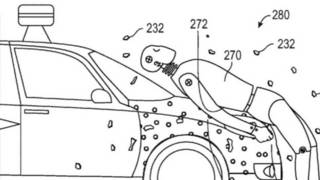 Image copyright google
Image copyright google
The cars driverless Google has starred in more than 340 incidents since the launch of the project in 2009, according to the latest giant technology.
the most recent occurred just three months ago in Mountain View, California, USA, when one of the autonomous vehicle collided with a city bus.
Luckily , no one was injured, but the left side of the Google car was completely destroyed.
Google knows that there is a high probability that their “smart” cars collide not only with other cars, but with some of pedestrians and cyclists who go their way.
So it has devised a solution that while it may seem a little bizarre, perhaps the most effective: a sticky hood in which the accident victim would attached like a fly .
Adhesion “almost instantaneous”
the patent approved May 17, proposes placing a strong adhesive on the hood of the vehicle to “catch” to pedestrians, bicyclists or animals.
“Ideally, the adhesive coating on the front of the vehicle can be activated by contact and will be able to join the pedestrian almost instantaneously “said a spokeswoman for Google.
according to the patent document this “instant or nearly instant action could help reduce the movement of pedestrians “, which will be transported in the front of the car until this (or the driver if the vehicle is not autonomous) “react and activate the brakes.”
Although the invention was devised specifically for cars without a driver, it is possible that it can be applied to other vehicles.
insufficient measures
Google seeks to avoid what is known as “secondary impacts” of traffic accidents, ie, hit the pedestrian with the vehicle.
According to the company, “the existing technology does little to mitigate the secondary impacts”, which can sometimes cause “serious injury or even death” .
Google cited car companies like Jaguar or Volvo, which already have technologies to reduce the effects on this type of shock .
for example, some Jaguar models have a pull-down hood that rises at the time of impact, softening the blow.
In addition, certain Volvo models have an airbag on the outside of the car in the area of the windshield, which aims to protect the victim of the collision of head injuries .
However, according to Google, these measures only protect the pedestrian “at the time of impact.”
the technology company says its style hood “flypaper” will have “the ability to increase safety and save lives.”
No comments:
Post a Comment